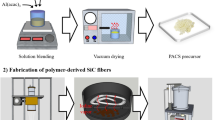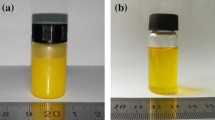Abstract
This paper is a review of structure and properties of ceramic fibers derived from organosilicon polymers, with emphasis on the author's research. Ceramic fibers are prepared from organosilicon polymers by melt-spinning, cross-linking, and pyrolysis. Desirable polymeric precursors display the following properties: high char yield of desired composition, thermal stability at melt-spinning temperature, stable rheology, high purity and freedom from particulate impurities, and ability to undergo rapid cure (cross-linking). Ceramic fibers in the Si-C-O or Si-C-N-O systems display a rich nanostructure consisting of some or all of the following metastable phases: (1) an amorphous, continuous siliconoxycarbide or siliconoxycarbonitride phase; (2) dispersed carbon nanocrystallites; (3) dispersed β-SiC or Si3N4 nanocrystallites; and (4) closed, globular nanopores. The crystalline phases increase in volume fraction and crystallite size as stoichiometry approaches the crystalline composition and as pyrolysis temperature increases. The Si-C-N-O fibers are amorphous. Pore size increases and total pore volume decreases with increasing pyrolysis temperature. Considerable variation in ceramic fiber composition can be achieved by varying cure conditions and pyrolysis atmosphere. Polycrystalline SiC fibers can be produced by pyrolysis above 1600°C. Fiber diameters range from 7 to 20 µm. Elastic moduli vary from 140 to >420 GPa (20 to >60 Msi) and are controlled by composition, nanostructure, and fiber density. Fiber densities range from ∼2.2 to >3.1 g/cm3. Tensile strengths range up to ∼5 GPa (700 ksi) and are Griffith flaw-controlled.
Similar content being viewed by others
References
D. C. Larsen and S. L. Stuchly, inFiber Reinforced Ceramic Composites, K. S. Mazdiyasni, ed. (Noyes, Park Ridge, NJ, 1990), pp. 182–221.
T. Mah, M. G. Mendiratta, A. P. Katz, and K. S. Mazdiyasni,Am. Ceram. Soc. Bull. 66, 304–308, 317 (1987).
R. Baney and G. Chandra, inEncyclopedia of Polymer Science and Engineering, Vol. 13, 2nd ed. (Wiley, New York, 1988), pp. 312–344.
N. R. Langley, G. E. LeGrow, and J. Lipowitz, inFiber Reinforced Ceramic Composites, K. S. Mazdiyasni, ed. (Noyes, Park Ridge, NJ, 1990), pp. 63–92.
R. M. Salinger, T. D. Barnard, C. T. Li, and L. G. Mahone,SAMPE Q. 19(3), 27 (1988).
S. Yajima,Am. Ceram. Soc. Bull. 62, 893 (1983).
S. Yajima, T. Iwai, T. Yamamura, K. Okamura, and Y. Hasegawa,J. Mater Sci. 16, 1349 (1981).
S. Yajima, K. Okamura, Y. Hasegawa, and T. Yamamura, U.S. Patents 4,359,559 (1982); 4,347,347 (1982); 4,515,742 (1985); 4,336,215 (1982).
J. P. Cannady, U.S. Patents 4,535,007 and 4,540,803 (1985).
G. E. LeGrow, T. F. Lim, J. Lipowitz, and R. S. Reaoch,Am. Ceram. Soc. Bull. 66, 363 (1987).
J. Gaul, Jr., U.S. Patents 4,312,970 and 4,340,619 (1982).
R. H. Baney, inUltrastructure Processing of Ceramics, Glasses, and Composites, L. L. Hench and D. R. Ulrich, eds. (Wiley, New York, 1984), pp. 245–255.
J. Lipowitz, N. Langley, G. LeGrow, and T. Lim,Ceram. Eng. Sci. Proc. 9, 931 (1988).
L. G. Mahone, U.S. Patent 4,772,516 (1988).
K. Okamura, M. Sato, T. Matsuzawa, T. Seguchi, and S. Kawanishi,Ceram. Eng. Sci. Proc. 9, 909 (1988).
K. Okamura, M. Sato, and Y. Hasegawa,Ceram. Int. 13, 55 (1987).
J. A. Rabe and D. R. Bujalski, U.S. Patent 4,761,389 (1988).
J. Lipowitz and J. A. Rabe, Unpublished data.
J. Lipowitz, H. A. Freeman, R. T. Chen, and E. R. Prack,Adv. Ceram. Mater. 2, 121 (1987).
J. Lipowitz and G. L. Turner,Polymer Preprints 29, 74 (1988);Solid State NMR of Polymers, L. J. Mathias, ed. (Plenum, New York), in press.
T. Taki, S. Maeda, K. Okamura, M. Sato, and T. Matsuzawa,J. Mater Sci. Lett. 6, 826 (1987).
V. S. R. Murthy, M. H. Lewis, M. E. Smith, and R. Dupree,Mater. Lett. 8, 263 (1989).
V. Belot, R. J. P. Corriu, D. LeClercq, P. H. Mutin, and A. Vioux,J. Mater Sci. Lett. 9, 1052 (1990).
J. Lipowitz, J. A. Rabe, and L. K. Frevel,J. Mater Sci. 25, 2118 (1990).
F. G. Rumscheidt and S. G. Mason,J. Colloid Sci. 17, 260 (1962).
H. S. Starrett, Unpublished observations, Southern Research Institute, Birmingham, AL.
Y. W. Chang, A. Zangvil, and J. Lipowitz,Ceram. Trans. Silicon Carbide '87 2, 435 (1989).
L. C. Sawyer, inFiber Reinforced Ceramic Fibers, K. S. Mazdiyasni, ed. (Noyes, Park Ridge, NJ, 1990), pp. 141–181.
Author information
Authors and Affiliations
Additional information
This review is from the Second International Topical Workshop, “Advances in Silicon-Based Polymer Science.”
Rights and permissions
About this article
Cite this article
Lipowitz, J. Structure and properties of ceramic fibers prepared from organosilicon polymers. J Inorg Organomet Polym 1, 277–297 (1991). https://doi.org/10.1007/BF00702494
Received:
Revised:
Issue Date:
DOI: https://doi.org/10.1007/BF00702494




